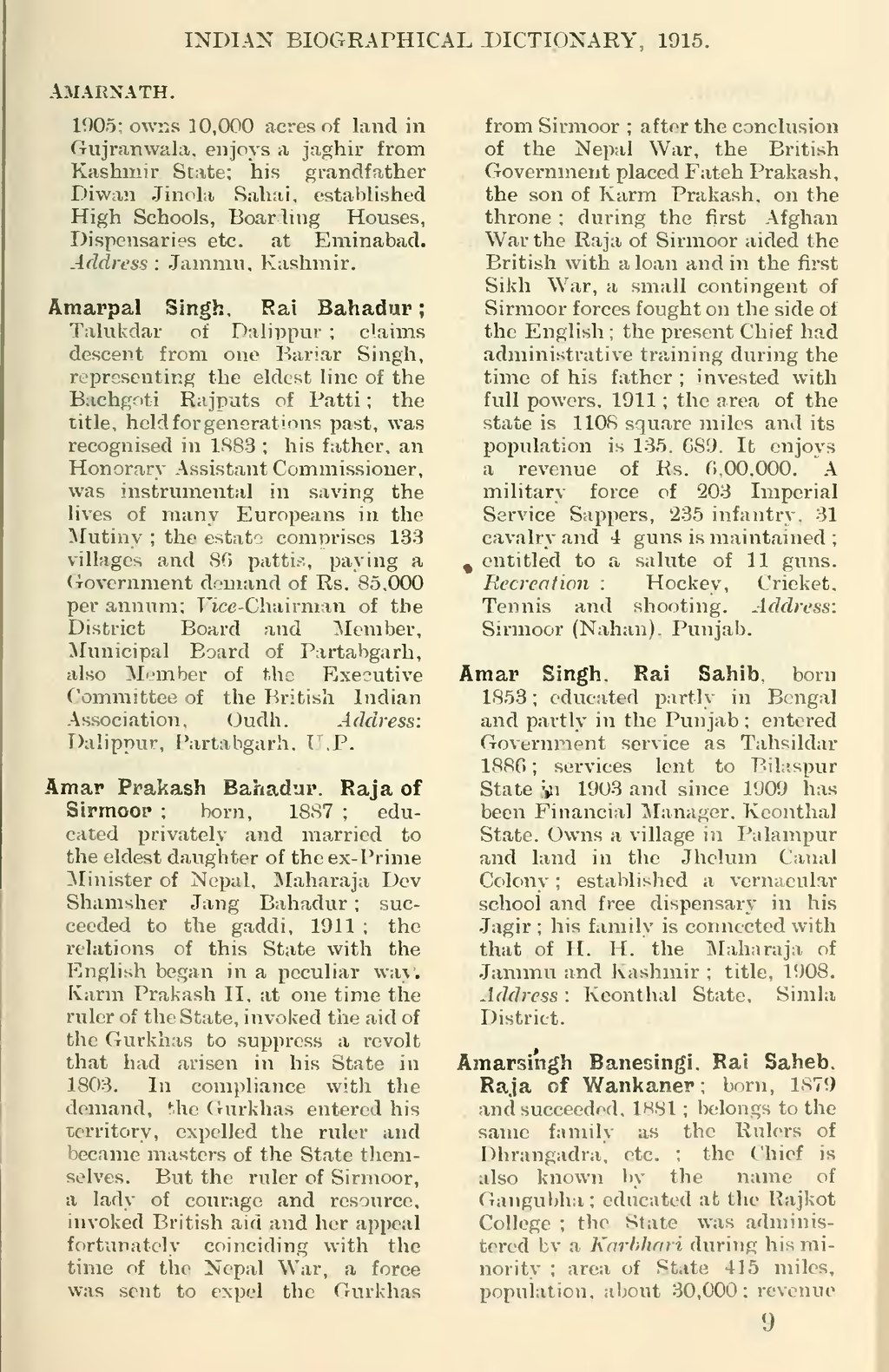INDIAN BIOGRAPHICAL DICTIONARY, 1915.
Amarnath.
1905; owns 10,000 acres of land in Gujranwala, enjoys a jaghir from Kashmir State; his grandfather Diwan Jinola Sahai, established High Schools, Boarding Houses, Dispensaries etc. at Eminabad. Address: Jammu, Kashmir.
Amappal Singh, Rai Bahadur; Talukdar of Dalippur; claims descent from one Bariar Singh, representing the eldest line of the Bachgoti Rajputs of Patti; the title, held for generations past, was recognised in 1883; his father, an Honorary Assistant Commissioner, was instrumental in saving the lives of many Europeans in the Mutiny; the estate comprises 133 villages and 80 pattis, paying a Government demand of Rs. 85,000 per annum; Vice-Chairman of the District Board and Member, Municipal Board of Partabgarh, also Member of the Executive Committee of the British Indian Association, Oudh. Address: Dalippur, Partabgarh. U.P.
Amar Prakash Bahadur. Raja of Sirmoor; born, 1887; educated privately and married to the eldest daughter of the ex-Prime Minister of Nepal, Maharaja Dev Shamsher Jang Bahadur; succeeded to the gaddi, 1911; the relations of this State with the English began in a peculiar way. Karm Prakash II, at one time the ruler of the State, invoked the aid of the Gurkhas to suppress a revolt that had arisen in his State in 1803. In compliance with the demand, the Gurkhas entered his territory, expelled the ruler and became masters of the State themselves. But the ruler of Sirmoor, a lady of courage and resource, invoked British aid and her appeal fortunately coinciding with the time of the Nepal War, a force was sent to expel the Gurkhas from Sirmoor; after the conclusion of the Nepal War, the British Government placed Fateh Prakash, the son of Karm Prakash, on the throne; during the first Afghan War the Raja of Sirmoor aided the British with a loan and in the first Sikh War, a small contingent of Sirmoor forces fought on the side of the English; the present Chief had administrative training during the time of his father; invested with full powers, 1911; the area of the state is 1,108 square miles and its population is 135,689. It enjoys a revenue of Rs. 6,00,000. A military force of 203 Imperial Service Sappers, 235 infantry, 31 cavalry and 4 guns is maintained; entitled to a salute of 11 guns. Recreation: Hockey, Cricket, Tennis and shooting. Address: Sirmoor (Nahan), Punjab.
Amar Singh, Rai Sahib, born 1853; educated partly in Bengal and partly in the Punjab; entered Government service as Tahsildar 1886; services lent to Bilaspur State in 1903 and since 1909 has been Financial Manager, Keonthal State. Owns a village in Palampur and land in the Jhelum Canal Colony; established a vernacular school and free dispensary in his Jagir; his family is connected with that of H.H. the Maharaja of Jammu and Kashmir; title, 1908. Address: Keonthal State, Simla District.
Amarsingh Banesingi, Rai Saheb, Raja of Wankaner; born, 1879 and succceded, 1881; belongs to the same family as the Rulers of Dhrangadra, etc.; the Chief is also known by the name of Gangubha; educated at the Rajkot College; the State was administered by a Karbhari during his minority; area of State 415 miles, population, about 30,000; revenue
